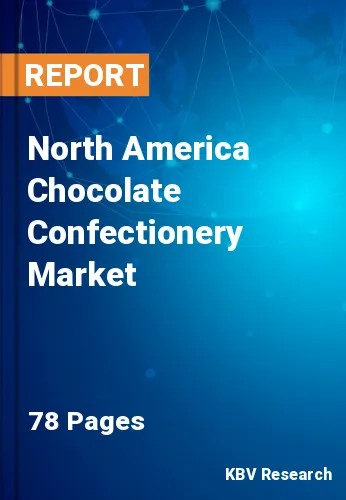The North America Chocolate Confectionery Market would witness market growth of 6.2% CAGR during the forecast period (2022-2028).
Low-sugar formulations are another trend within the chocolate confectionery sector, with creative solutions that enable sugar to be lowered by adding extracts from a variety of fruits, such as strawberry, cherry, watermelon, and lemon. Consumers no longer accept knowing what components a product contains, instead, they demand to know where each item comes from and how it is verified. As a result, chocolate snacks with easily identifiable ingredients are popular, and this is a crucial claim to make when urging people to buy them.
Premium quality confectionery items with a broad range of textures are in high demand among consumers. In addition, numerous consumers all over the world are willing to spend more for items with diverse textures, flavors, and premium quality. The market's leading brands are also increasing their investments in order to meet such demands of their consumers. For example, premium brand Baron Chocolatier debuted a product line of bars exclusively for Dollar Stores in the United States in September 2021. Five varieties, including milk mousse, peanut butter, and creamy caramel, are available in the product line. These bars are Kosher-certified, trans-fat-free, and GMO-free.
Because of the expanding demand for premium chocolate confectioneries, North America is one of the largest markets for chocolate confectionery. The demand for clean-label and organic chocolate confectioneries is also significantly growing. Consumers are seeking products that are healthy as well as indulgent. Dark chocolate is rapidly gaining popularity across this region, owing to an increase in the awareness of the health advantages of cocoa. Additionally, consumers' growing demand to know where their chocolate comes from and their worries about labor rights are likely to drive up the demand for fair-traded cocoa and chocolate, bolstering the region's position in the chocolate confectionery market.
Further, Canada is also a very big market for chocolate confectionaries. According to the Inter-American Institute for cooperation on agriculture, Canada is one of the world's largest chocolate consumers. Canadians consume 6.4 kg of chocolate each year on average, or 160 bars per person, making Canada the world's ninth-highest chocolate consumer, one kg more than the United States. Therefore, due to the constantly rising consumption of chocolates, the regional market is estimated to significantly flourish in the coming years.
The US market dominated the North America Chocolate Confectionery Market by Country 2021, and would continue to be a dominant market till 2028; thereby, achieving a market value of $53,803.1 million by 2028. The Canada market is estimated to grow at a CAGR of 8.6% during (2022 - 2028). Additionally, The Mexico market would display a CAGR of 7.7% during (2022 - 2028).
Based on Type, the market is segmented into Milk, Dark, and White. Based on Distribution Channel, the market is segmented into Supermarkets & Hypermarkets, Convenience Stores, Online, and Others. Based on Product, the market is segmented into Molded Bars, Chips & Bites, Boxed, Truffles & Cups, and Others. Based on countries, the market is segmented into U.S., Mexico, Canada, and Rest of North America.
Free Valuable Insights: The Global Chocolate Confectionery Market is Estimated to reach $265.9 Billion by 2028, at a CAGR of 6.7%
The market research report covers the analysis of key stake holders of the market. Key companies profiled in the report include Ferrero Group, The Hershey Company (Hershey Trust Company), Lindt & Sprungli AG, Mars, Inc., Mondelez International, Inc., Nestle S.A., The Barry Callebaut Group, Lotte Corporation, Lake Champlain Chocolates, and CÉMOI Group.
By Type
By Distribution Channel
By Product
By Country
Our team of dedicated experts can provide you with attractive expansion opportunities for your business.

